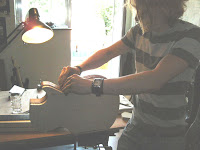I conducted some different stringing experiments; after two trials with a set of guitar strings (2 wound, 1 plain) and one trial with a snare drum mat, I will now start building a nicer, slimmer, lighter version with the traditional system of three unwound guitar strings cutting through the two high corners of the 'tabla' (sound board). This cajon, CA003, will be a real, playable and polished instrument.
(CA001 is an unfinished box that I've had standing around for some time - it was too heavy so I started on CA002 instead)




















































